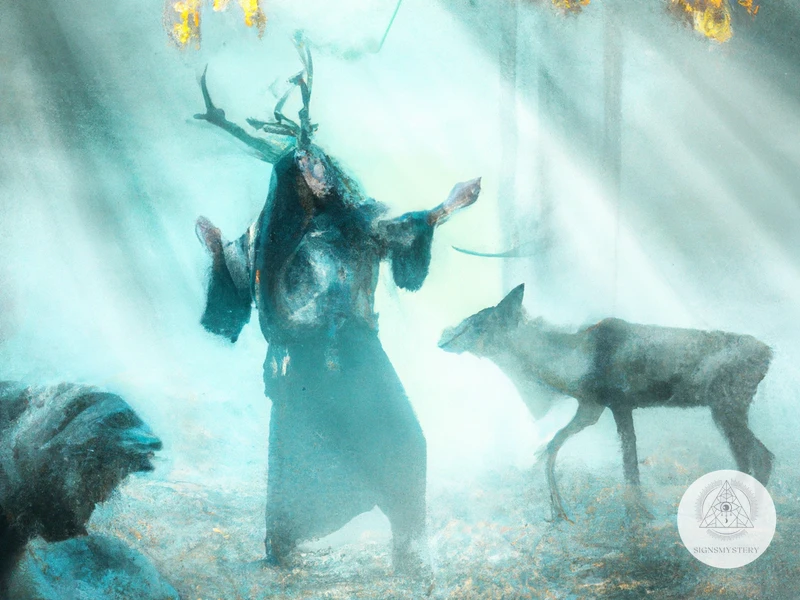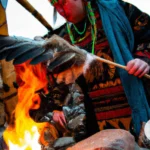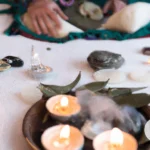Embarking on a shamanic journey can be a transformative experience that allows for deep self-discovery, spiritual growth, and even healing. However, it is important to prepare properly in order to fully reap the benefits of this ancient practice. In this guide, we will take a step-by-step approach to preparing for a shamanic journey, including finding a reputable shaman, setting your intention, preparing your mind and body, creating a sacred space, and more. By following these preparatory steps and knowing what to expect during the journey itself, you can fully immerse yourself in the experience and come away with new insights and a deeper connection to yourself and the spiritual realm.
What is Shamanism?

Shamanism is an ancient practice that originated from indigenous cultures all over the world. It is a way of connecting with the spiritual realm and the natural world through shamanic journeying, rituals, and ceremonies. In shamanism beliefs, everything is interconnected, and all beings have a spirit, including animals, plants, rocks, and even inanimate objects. The shaman, or the spiritual healer and guide, is believed to have the ability to communicate with the spirits and use their wisdom and power for healing and self-discovery. Shamanic journeying is a powerful tool for self-discovery and healing, as it allows one to connect with their inner world and spirit guides. By embarking on a shamanic journey, one can retrieve lost energy, gain spiritual growth and connection, and experience emotional healing.
Ancient Practice
The practice of shamanism is an ancient tradition that dates back thousands of years. It is believed to have originated in Siberia and then spread throughout the world, evolving and taking on different forms in different cultures. Shamanism is rooted in the belief that everything in the universe is interconnected and that by connecting with the spiritual world, we can bring balance and harmony to our lives.
Shamans are spiritual leaders who have a deep understanding of the spiritual world and the interconnectedness of all things. Traditionally, they were the healers, teachers, and problem-solvers of their communities. They used various techniques, such as chanting, drumming, and dancing, to enter into altered states of consciousness and connect with the spirit realm.
One of the key beliefs of shamanism is that everything in the physical world has a spiritual counterpart. This includes animals, plants, and even inanimate objects. Shamans believe that by connecting with these spiritual counterparts, they can access their wisdom and healing powers.
The practice of shamanism has survived through the ages because of its effectiveness in promoting healing and well-being. It is still practiced today by many indigenous cultures and has gained popularity in the West in recent years.
If you’re interested in learning more about shamanism and its benefits, check out our article on Benefits of Shamanic Journeying. Understanding the ancient roots and beliefs of shamanism can help you on your own journey of shamanic self-discovery.
Shamanism Beliefs
Shamanism beliefs are centered around a deep connection to nature and the spiritual world. Shamans believe that everything in the universe is interconnected, and that by tapping into the spiritual realm, they can gain insight and healing that is not available through conventional means. They believe in the existence of a spiritual world that is just as real as the physical world, and that the two are intertwined.
Some core beliefs in shamanism include:
| Animism | – The belief that all things have a spirit or soul, including plants, animals, and even rocks and mountains. |
| Spirits and Spirit Guides | – The belief that there are spirits and spirit guides that can provide guidance, healing, and protection to those who seek it. |
| The Journey | – The belief that shamans can journey to the spiritual realm to gain insight, wisdom, and healing. This journey may be undertaken through the use of shamanic drumming, dancing, chanting, or the use of plant medicines. |
| Energy and Power | – The belief that everything in the universe is made up of energy, and that shamans can harness and direct this energy to promote healing and transformation. |
| Interconnectedness | – The belief that all things in the universe are interconnected, and that by addressing imbalances in one area, a ripple effect of healing can occur throughout the entire system. |
| Ritual and Ceremony | – The belief in the power of ritual and ceremony to create a sacred space and foster deep healing and transformation. |
Shamanism beliefs recognize that the universe is full of symbols and meanings that can be used to understand ourselves and the world around us on a deeper level. The shamanic journey often involves the interpretation of symbols and imagery encountered during the journey, which can offer deep insights into one’s life path and purpose. This is why shamanism is often used for self-discovery and personal growth.
If you want to know more about the symbolism encountered during shamanic self-discovery journeys, check out our article Shamanic Self-Discovery: Understanding the Symbolism Encountered During a Journey. You may also be interested in learning more about spirit guides and their role in shamanic journeying, which you can find in our article The Role of Spirit Guides in Shamanic Journeying.
The Role of the Shaman
in shamanism is critical to the practice of a shamanic journey. The shaman is an intermediary between the human world and the spiritual realm, and serves as a guide for those seeking self-discovery and healing. The shaman is responsible for preparing and holding a sacred space for the journey and establishing a connection with the spirit world.
During the journey, the shaman will work with the participant, helping them navigate the spiritual realm and assisting in the interpretation of their experiences. The shaman will use their skills, knowledge, and intuition to help the participant gain clarity and insights that they may not have been able to access on their own.
The shaman may also facilitate healing by performing energetic or physical work on the participant. This can involve extracting negative energy or attachments that are causing illness or discomfort, or restoring lost energy or power. The shaman may use various tools, such as feathers, crystals, or stones, to aid in this process.
It is important to note that the role of the shaman is not to heal or fix the participant, but rather to facilitate their own self-discovery and healing. The shaman is there to guide and support, but it is ultimately up to the participant to do the work and integrate the lessons learned from the journey into their daily life.
If you’re interested in experiencing a shamanic journey for self-discovery, it’s important to find a reputable shaman who you trust and feel comfortable with. Check out our article on shamanic self-discovery for more information on the benefits of shamanic journeying and how it can help you on your path of spiritual growth.
Benefits of a Shamanic Journey
Embarking on a shamanic journey can provide numerous benefits for individuals seeking self-discovery and healing. One of the primary benefits is the opportunity for spiritual growth and connection. During a shamanic journey, individuals may meet their spirit guides, ancestors, or other spiritual beings, and establish a deeper connection to the spiritual realm. Additionally, a shamanic journey can aid in retrieving lost energy or power from past traumas or negative experiences. This can lead to a sense of empowerment and renewed energy in daily life. In addition to emotional healing, shamanic journeying can also reveal meaningful insights about our past lives. By exploring our past lives, we can gain a better understanding of our current life’s purpose and direction. Ultimately, the benefits of a shamanic journey can vary from person to person, but it often leads to personal transformation and a deeper understanding of oneself.
Self-Discovery and Healing
Self-discovery and healing are two significant outcomes that people seek from shamanic journeys. Shamanic journeying is an immersive and introspective experience that takes an individual to a trance state where they can access their subconscious mind and explore their inner selves. During a shamanic journey, participants often encounter aspects of themselves that they weren’t aware of or have long forgotten. Shamans believe that past experiences and traumas that are buried in the subconscious mind can cause physical, emotional, and mental imbalances and illnesses. By accessing and resolving these hidden issues during a shamanic journey, individuals can experience profound healing and transformation.
Through shamanic journeying, individuals may discover their true purpose, passions, and desires, thereby gaining a new appreciation for themselves and their lives. This can lead to greater self-awareness, confidence, and a renewed sense of direction. Additionally, the self-discovery that takes place during a shamanic journey can help individuals gain clarity on relationships and how they interact with the world.
In terms of healing, shamanic journeying can help individuals to release deep-seated emotional wounds and traumas and provide them with the tools needed to work through those issues. This can bring about an overall sense of peace, calmness, and mental clarity. Shamanic journeying can also help with physical ailments as it can reduce stress and tension and help to improve the immune system.
Shamanic journeying allows individuals to connect with their spirit guides or animal totems who provide them with guidance and wisdom that help them through the healing process. These guides can also accompany individuals in their continued healing journey outside of the shamanic journey.
Overall, self-discovery and healing are intimately related, and shamanic journeying can help people to achieve both. It provides individuals with space to delve into their subconscious mind, connect with their inner selves, and begin the healing process of physical, emotional, and mental imbalances and illnesses. Whether you’re seeking to identify your purpose, release emotional wounds, or find spiritual guidance, shamanic journeying can provide a transformative and restorative experience.
Spiritual Growth and Connection
One of the most significant benefits of a shamanic journey is the potential for spiritual growth and connection. During a journey, you have the opportunity to connect with your inner self and higher power. As you journey, you may feel a deep sense of connection to something greater than yourself. This connection can help you cultivate a greater understanding of the world and your place in it.
In today’s busy world, it’s easy to feel disconnected from the spiritual realm. A shamanic journey can help you reconnect with this realm and develop a deeper sense of purpose and meaning in your life. As you discover more about your true self, you may also find your spirituality growing deeper.
Another way that a shamanic journey can promote spiritual growth is by providing a safe space for exploration and experimentation. The journey can be a place where you can push beyond your comfort zones and explore new territory. As you try out new ideas, you may discover aspects of yourself that you never knew existed. This can lead to a greater understanding of yourself, others, and the world.
A shamanic journey can be a powerful tool for spiritual growth and connection. Through the journey, you can connect with your inner self and the spiritual realm, and cultivate a deeper sense of purpose and meaning in your life. If you’re interested in learning more about shamanic journeying, check out these tips for exploring past lives or healing emotions through journeying.
Retrieving Lost Energy or Power
Retrieving Lost Energy or Power: One of the primary benefits of shamanic journeying is the ability to retrieve lost energy or power. This can occur due to various reasons such as emotional trauma, illness, or past relationships. During a shamanic journey, the shaman can help you identify and access the lost energy or power that you require to heal and move forward.
In order to retrieve your lost energy or power during a shamanic journey, the shaman may lead you into a deeper state of consciousness. This can help you connect with your inner self, past experiences, and the spirit world. Once you have reached this state, you may be able to see and feel the parts of yourself that you have lost and retrieve them.
Retrieving lost energy or power is not always a comfortable process. It can sometimes be challenging to confront past experiences or emotions that have caused you to lose your energy or power. However, the journey can provide you with a safe space to do so, and with the help of the shaman and your spirit guides, you can start to heal.
It is important to note that retrieving lost energy or power is not a quick fix solution. It can often take several journeys to fully restore lost energy or power, and it is important to continue the integration and reflection process after the journey to fully embody the lessons learned.
If you have been feeling stuck or powerless, a shamanic journey may be able to help you retrieve lost energy or power. It can provide a safe, supportive space for you to confront past trauma and start the healing process. Remember, healing is a gradual process, and it is important to be patient and compassionate with yourself throughout the journey.
How to Prepare for a Shamanic Journey

Preparing for a Shamanic Journey is an important step towards achieving the desired results of the experience. The first step is finding a reputable Shaman, someone trained and experienced in guiding Shamanic Journeys. After finding a Shaman, set a clear intention for the journey. Visualize what you want to achieve and what you need help with. Preparing your mind and body is also necessary, through meditation, relaxation techniques, and avoiding substances that could interfere with the experience. Gathering tools and offerings like crystals, tobacco, and sage can help set the intention and create a sacred space. Creating a sacred space involves finding a quiet, comfortable space where the Shamanic Journey will take place. The space must be cleared of any distractions. Finally, entering a trance state is key to experiencing the Shamanic Journey. This can be done through drumming, dance, or meditation.
Find a Reputable Shaman
When looking to embark on a shamanic journey, finding a reputable shaman is crucial. It is important to find someone who has experience and training in shamanic practices. But how can you find a reputable shaman?
Research: Start by researching online or asking for recommendations from people you trust. Look for shamans who have positive reviews or testimonials from previous clients.
Experience: Look for shamans who have been practicing for several years. This suggests that they have developed skills and have experience working with a variety of clients and situations.
Referrals: Ask for referrals from other healers, therapists, or counselors. Often, they know reputable shamans in the area or can refer you to someone they trust.
Training: Look for shamans who have received training and certification from a recognized institution. This ensures that they have a solid foundation in shamanic practices and have received proper guidance and mentorship.
Meet and Interview: Before booking a session, it is important to schedule a meeting with the shaman to ask questions and get a feel for their energy and approach. Ask about their training, experience, and any questions you may have about the process.
Finding a reputable shaman requires research, referrals, and careful consideration. Take the time to find a qualified shaman who resonates with you and is able to provide safe and effective guidance on your shamanic journey.
Set Your Intention
Setting your intention is a crucial step in preparing for a shamanic journey. It is important to have a clear focus and a specific goal in mind. This intention will guide the journey and help you to receive the insights that you need.
Here are some tips on how to set your intention:
- Reflect on your current situation: Before setting your intention, take some time to reflect on your current situation. What issues or challenges are you facing? What do you hope to gain from the shamanic journey?
- Be specific: Your intention should be specific and clear. Avoid generalizations such as “I want to be happier.” Instead, focus on a specific area such as “I want to overcome my fear of public speaking.”
- Use positive language: Phrase your intention in positive language, as if you have already achieved your goal. For example, “I am confident and comfortable speaking in front of others.”
- Visualize: Use visualization techniques to help you form your intention. Imagine yourself already having achieved your goal and how it will impact your life.
- Write it down: Write down your intention and keep it with you. This will help you stay focused and remind you of your goal throughout the journey.
- Stay open: While it is important to have a clear intention, it is also important to stay open to any insights or messages that may come through during the shamanic journey. Trust the process and allow yourself to be guided.
By setting your intention, you will be able to focus your energy and attention on what is most important to you. This will help to ensure a meaningful and transformative shamanic journey.
Prepare Your Mind and Body
Preparing your mind and body is an important step in getting ready for a shamanic journey. You want to be relaxed, focused, and in the right mindset to fully benefit from the experience. Here are some tips for preparing your mind and body:
| Tip | Description |
|---|---|
| Meditation or relaxation techniques | Practice meditation or relaxation techniques before your shamanic journey to help calm your mind and release any physical tension or stress. |
| Healthy diet | Try to eat a healthy meal or snack before your journey, preferably one that is high in protein and low in sugar. Avoid heavy or spicy foods that may cause indigestion or discomfort. |
| Avoid alcohol and drugs | Avoid using alcohol or drugs before your journey, as they can interfere with the experience and potentially cause harm to your mind and body. |
| Get plenty of rest | Make sure you are well-rested before your journey, as fatigue can affect your ability to concentrate and fully engage in the experience. |
| Stretching or yoga | Consider doing some light stretching or yoga before your journey to help release any physical tension and increase your overall relaxation. |
Remember, the more you prepare your mind and body, the better your experience of a shamanic journey will be. Take the time to invest in yourself and your well-being beforehand to ensure you get the most out of the experience.
Gather Tools and Offerings
During a shamanic journey, it’s important to have certain tools and offerings with you in order to enhance your connection with the spiritual world. These items can physically and mentally prepare you for the journey ahead.
One common item to bring is a rattle. The sound of a rattle can help you enter a trance state and can also help you shift your focus from the outside world to your inner world. Another common item to bring is sage or palo santo to burn as incense, which can help cleanse and purify the space before and during the journey.
You may also choose to bring a crystal or stone that resonates with you or has a specific meaning or energy. Holding it during the journey can help you tap into its energy and bring that energy into the experience. Additionally, some people find it helpful to have a drum or other instrument to help them create a rhythm and connect with their journey.
In terms of offerings, it can be beneficial to bring something to give back to the spirits or guides who may assist you during the journey. This could be anything from a small piece of jewelry or a feather to something that has deep personal significance to you.
Remember that the items you choose to bring should have personal meaning and significance to you. Spend some time meditating and connecting with your intentions for the journey, and let your intuition guide you in choosing the right tools and offerings for your experience.
By gathering these tools and offerings, you can create a more meaningful and powerful experience during your shamanic journey. They can help you connect with the spiritual world in a deeper way and support you on your path of self-discovery and healing.
Create a Sacred Space
Creating a sacred space for your shamanic journey is an essential step in order to feel safe and protected while you open yourself up to the spirit world. It allows you to focus your intention and channel your energy for the journey ahead.
The first step in creating a sacred space is to find a location where you feel comfortable and at ease. You can either choose a private space in your home or find a peaceful outdoor location such as a forest, beach, or park. Whichever location you choose, be sure to clear the space of any clutter or distractions.
Next, you can add sacred elements to your space such as candles, crystals, incense, or spiritual symbols. These items can help to create a relaxing and peaceful atmosphere, and can also serve as a reminder of the sacredness of the space. You can choose items that resonate with you personally, or that have specific meaning or significance to your spiritual practice.
Another important aspect of creating a sacred space is to set an intention for your journey. This could be a specific issue you want to explore or a general desire for spiritual growth or healing. Whatever your intention may be, it is important to bring it to the forefront of your mind and connect with it before beginning your journey.
Once you have set your intention, it can be helpful to call in spiritual allies, such as your spirit guides or power animals, to provide guidance and protection during your journey. You can do this through prayer, meditation, or visualization.
Lastly, you may want to smudge the space with sage or another cleansing herb in order to purify and protect the area from negative energy. This can be done by lighting the herb and allowing the smoke to permeate the space, or by using a smudging spray.
Remember, creating a sacred space for your shamanic journey is a personal and individual process. Feel free to customize your space in any way that feels meaningful and authentic to your own spiritual practice.
Enter a Trance State
Entering a trance state is an essential part of the shamanic journey process. It allows individuals to connect with the spirit world and their inner selves on a deeper level. Here are some techniques that can be used to enter a trance state:
| Technique | Description |
|---|---|
| Drumming and Chanting | Repetitive drumming and chanting can alter brainwaves and induce a trance state. It’s important to find a comfortable rhythm and volume. |
| Breathwork | Conscious breathing can calm the mind and body and create an altered state of consciousness. This can be done by taking deep, slow breaths and exhaling fully. |
| Meditation | Using meditation techniques such as visualization, mindfulness, and guided imagery can help to relax the body and mind and enter a trance state. |
| Dancing | Moving the body freely to music can help to enter a trance state and connect with one’s inner self and the spirit world. |
| Ayahuasca or other Psychedelic Substances | Ayahuasca or other psychedelic substances can induce an altered state of consciousness and facilitate a shamanic journey. However, it’s important to work with a trained shaman and approach these substances with caution and respect. |
It’s important to find a technique that resonates with you and to practice it regularly before going on a shamanic journey. This can help to deepen the trance state and make it easier to enter and maintain. Remember to set your intention before entering the trance state, as this will guide the journey and ensure a more meaningful experience.
What to Expect During a Shamanic Journey
During a shamanic journey, you can expect to enter a trance-like state where you can access non-ordinary reality and communicate with your spirit guides. One of the main goals of a shamanic journey is to gain spiritual insight and self-discovery, which can be achieved through meeting with your spirit guides
Subscribe to Our Newsletter
Sign up to receive the latest news and updates.
Meeting Your Spirit Guides
As you enter a shamanic journey, you will have the opportunity to meet your spirit guides, who are benevolent beings that exist in the spiritual realm. These guides are often animals, ancestors, or other entities that are uniquely suited to help you on your journey. It is important to approach meeting your spirit guide with an open mind and heart, as they have valuable wisdom and insights to share with you.
Visualize Your Spirit Guide
One way to connect with your spirit guide is through visualization. As you enter a trance state, visualize yourself walking along a path in nature. Imagine your spirit guide approaching you on the path, and take note of any details you notice about their appearance. Trust your intuition and allow yourself to fully connect with your guide.
Listen to Your Guide’s Message
Your spirit guide may have a message or lesson to share with you during your journey. Be open and receptive to their guidance, and listen carefully to their words. You may also receive messages through imagery, symbols, or other sensations. Trust in the wisdom of your guide and know that their guidance is meant to assist you on your journey towards self-discovery.
Show Gratitude
After meeting your spirit guide, it is important to show gratitude for their guidance and support. You may do this through prayer, meditation, or by offering a small gift or token of appreciation. Expressing your gratitude will help to strengthen your connection with your spirit guide and deepen your understanding of the spiritual realm.
Meeting your spirit guide is a powerful and transformative experience, and with an open heart and mind, you can gain valuable insights and guidance to help you on your journey towards self-discovery. Remember to approach this experience with respect and reverence, and honor the wisdom and guidance of these benevolent beings.
Journey Imagery
During a shamanic journey, the traveler is taken on a spiritual experience through imagery and visualization. This imagery is often rich in symbolism and can be confusing or even frightening. However, it is important to trust the process and allow the imagery to unfold.
Some common examples of journey imagery include:
| Animal Guides: | These spirit animals are believed to offer guidance and protection during the journey. The animal may communicate important messages or even become a spirit ally for the traveler. |
| Nature Scenes: | The traveler may see themselves in a forest, by a waterfall, or on a mountaintop. These environments are often associated with healing and renewal. |
| Archetypes: | The traveler may encounter universal symbols like a wise old man or woman, a trickster figure, or a nurturing mother. These archetypes can represent different aspects of the traveler’s psyche or provide guidance and teaching. |
| Ancestral Spirits: | The traveler may connect with ancestors or loved ones who have passed on. These spirits may offer healing or messages from beyond the physical realm. |
It’s important to remember that journey imagery is highly personal and can vary widely between individuals. Some travelers may encounter these common themes, while others may experience something entirely unique.
Interpreting the imagery is also a highly individualized process. It’s important to reflect on the experience and seek guidance from a shaman or spiritual counselor if necessary. Writing down the imagery and any emotions or impressions associated with it can also be helpful for future reflection and integration.
Challenges and Obstacles
During a shamanic journey, it is common to encounter various challenges and obstacles that may hinder your journey. These may include physical discomfort, emotional distress, or mental blockages. However, embracing these challenges can be an important aspect of growth and transformation.
One common obstacle is encountering fears or negative thought patterns, which can arise when exploring the unknown depths of your inner self. It is important to recognize these thoughts and feelings and acknowledge them without judgement. Try to take a step back and observe them objectively, rather than getting caught up in them. Remember that these thoughts and feelings are a natural part of the journey and can ultimately lead to greater understanding and self-awareness.
Another challenge that may arise is encountering difficult or uncomfortable imagery during your journey. This can include confronting past traumas or unresolved emotions. Again, it is important to approach these experiences with openness and curiosity, rather than turning away from them. Trust that the journey is guiding you towards healing and growth, even if the process may be difficult.
Physical discomfort or distractions can also pose as a challenge during a shamanic journey. This can include restlessness, fatigue, or discomfort in the body. Try your best to remain present and focused, without getting too caught up in these physical sensations. You can also prepare your body beforehand by stretching or doing light exercises.
Lastly, it is important to note that not every journey will be smooth or transformative. Sometimes, obstacles and challenges may arise that you may not be ready to confront. This is okay, and it is important to listen to your intuition and take a step back if needed. Remember that self-discovery is a journey, and there will be both ups and downs along the way.
Common Challenges and Obstacles during a Shamanic Journey:
| Challenge/Obstacle | How to Approach |
|---|---|
| Fears/negative thoughts | Acknowledge without judgement, observe objectively |
| Difficult/uncomfortable imagery | Approach with openness and curiosity, trust the journey |
| Physical discomfort/distractiosn | Remain present and focused, prepare body beforehand |
| Not every journey will be smooth | Listen to intuition, take a step back if needed |
Retrieving Lost Energy or Power
Retrieving lost energy or power is an important aspect of shamanic journeys and is often a reason why many people seek out a shamanic practitioner. When we experience trauma, illness, or other difficult life events, we may lose a part of ourselves. This can manifest as a lack of energy, motivation, or enthusiasm for life. It can also show up as physical ailments or chronic pain.
During a shamanic journey, the shaman and the client can work together to identify where the lost energy or power exists and retrieve it. This process can be done through visualization and deep connection with one’s own inner guidance system.
The shamanic practitioner can help the client navigate this process by guiding them to explore the root cause of their energy loss and what they need to do to retrieve that energy or power. This may involve connecting with spirit guides or ancestors to gain insight into the situation.
Once the lost energy or power is identified, the shamanic practitioner can retrieve it and help the client integrate it back into their physical body. This process can be empowering for the client, as they reclaim a part of themselves that was lost.
It’s important to note that retrieving lost energy or power is not a quick fix for deeper emotional or psychological issues. However, it can be a beneficial tool to help restore balance and wholeness to the self. Ongoing work may be necessary to fully heal and integrate these deeper issues.
Retrieving lost energy or power can be a transformative experience for those who feel they have lost a part of themselves. Through shamanic journeying, one can connect with their own inner guidance and spirit helpers to retrieve what was once lost and renew their strength and vitality.
Integration and Reflection
After completing a shamanic journey, it is essential to take the time for integration and reflection. Grounding and centering practices can help you process the experience and return to the present moment. Consider journaling and reflecting on your journey, as it allows you to make sense of the images and messages received during the journey. It’s also imperative that you work to integrate the lessons learned into your daily life. The insights gained from a shamanic journey can be profound, and taking action to put them into practice can bring about real and transformative change in your life. Whether it be in the form of new daily habits or relationships, taking the time to reflect and integrate can lead to a more fulfilling life journey.
Grounding and Centering
Grounding and centering are important practices in shamanism, and they help you integrate the lessons learned during your journey into your daily life. Grounding is the practice of connecting to the Earth’s energy, while centering is finding balance within yourself. To ground yourself after a shamanic journey, find a quiet place where you can sit or stand barefoot on the Earth. Close your eyes and imagine roots growing from the bottom of your feet and into the Earth. As you inhale, imagine that you are taking in the Earth’s energy through these roots. As you exhale, release any negative energy or tension. Repeat this process until you feel calm and centered.
To center yourself, focus on your breath. Close your eyes and take deep breaths, inhaling through your nose and exhaling through your mouth. Imagine a strong inner core within yourself, like a pillar of light. As you inhale, imagine that you are drawing energy up from the Earth into this core. As you exhale, release any negative energy or tension and feel yourself becoming more centered and balanced.
In addition to these practices, you can also use crystals to help ground and center yourself. Some good options for grounding include black tourmaline, hematite, and smoky quartz, while amethyst, clear quartz, and rose quartz are good for centering.
It’s important to practice grounding and centering regularly, not just after a shamanic journey. Doing so can help you stay connected to the present moment, reduce stress and anxiety, and increase overall well-being. Incorporate these practices into your daily routine to stay grounded and centered.
Journaling and Reflection
Journaling and reflection are powerful tools for processing and integrating the insights gained from a shamanic journey. After returning from your journey, take some time to write down everything that you experienced, saw, and felt. Writing things down can help to solidify the images and messages that came through during your journey, making it easier to remember them later.
As you journal about your experience, try not to analyze or judge what you are writing. Just let the words flow onto the page without censoring yourself. You may find that certain themes or messages emerge, or that your journey took on a different meaning than you initially thought.
Once you have finished journaling, take some time to reflect on what you have written. Sit with the information and see if any new insights or interpretations emerge. You may want to read your journal entry out loud, or discuss your experience with a trusted friend or therapist.
Reflection can also include meditation or quiet contemplation. Take some time to sit in silence, allowing any emotions or thoughts to arise naturally. You may find that you have a deeper understanding of your journey or that certain realizations come to light.
Remember that the insights gained from a shamanic journey can take time to fully integrate into your daily life. Be patient with yourself and continue to reflect and journal as needed. With time and practice, you may find that the lessons learned during your journey become a natural part of your life and personal growth journey.
Integrating Lessons Learned
Integrating lessons learned during a shamanic journey is a crucial step in the process of personal growth and transformation. Once the journey is complete, it is important to take the time to reflect on the experience and incorporate the insights gained into daily life.
Here are some steps to help integrate lessons learned from a shamanic journey:
1. Review and Reflect: Take some time to sit with your journey experience. Consider any insights, messages, or symbols that appeared during the journey. Write them down and reflect on the possible meanings and how they apply to your life.
2. Make a Plan: Identify specific changes you can make in your life based on the lessons learned from the journey. Develop a plan to implement these changes and commit to taking action.
3. Seek Support: Share your journey experience and insights with trusted friends or family members. Seek support and encouragement from those who are aligned with your personal growth journey.
4. Practice Mindfulness: Incorporate mindfulness practices into your daily routine. This can help you stay connected to the lessons learned during the journey and reinforce the changes you are making.
5. Take Action: Follow through on the plan you developed in step two. Make the changes you identified and track your progress. Celebrate small successes along the way and stay committed to your personal growth journey.
Integrating lessons learned from a shamanic journey can take time and effort, but the rewards can be significant. By staying committed to the process of personal growth and transformation, you can continue to evolve and develop a deeper connection to yourself and the world around you.
Conclusion
In conclusion, embarking on a shamanic journey can be a transformative experience for those seeking self-discovery, spiritual growth, and healing. By finding a reputable shaman, setting your intention, and preparing your mind and body, you can create a safe and sacred space to enter a trance state and connect with your spirit guides.
During the journey, you may face challenges and obstacles, but with the guidance of your spirit guides, you can retrieve lost energy or power and gain valuable insights and lessons. It is important to take the time to integrate and reflect on your journey through grounding and centering exercises, journaling, and reflection to fully grasp the meaning and benefits of your experience.
By following these steps and embracing the gifts of shamanic journeying, individuals can discover a deeper sense of self and purpose, connect with the spiritual realm, and embark on a journey towards greater healing and wellness.
Remember, the journey does not end with the ceremony. Make sure to continue to nurture your self-discovery and spiritual growth by incorporating the lessons learned and cultivating a practice that resonates with you. Trust in the guidance of your spirit guides and the power of your own inner wisdom to continue your journey towards a more fulfilled and authentic life.
Key Takeaways
- Shamanism is an ancient practice that can offer individuals a transformative experience through self-discovery, spiritual growth, and healing.
- To prepare for a shamanic journey, it is important to find a reputable shaman, set your intention, prepare your mind and body, gather tools and offerings, and create a sacred space.
- During the journey, individuals may face challenges and obstacles, but with the guidance of their spirit guides, they can retrieve lost energy or power and gain valuable insights and lessons.
- Integration and reflection are key components of the shamanic journey process, through grounding and centering exercises, journaling, and reflection.
- By embracing the gifts of shamanic journeying and continuing to cultivate a practice that resonates, individuals can embark on a journey towards greater wellness and fulfillment.
Frequently Asked Questions
1. Can Shamanic Journeying be Done Alone?
Yes, it is possible to practice Shamanic Journeying alone. However, it is recommended to have guidance from a reputable shaman until you feel comfortable enough to do it on your own.
2. Is Shamanism a Religion?
No, Shamanism is not a religion but rather a spiritual practice that dates back over 40,000 years. It centers on a connection with nature and the spiritual realm.
3. Can Anyone Practice Shamanism?
Yes, anyone can practice Shamanism. It is not limited to any specific culture or religion. However, it is essential to approach it with the right intention and respect for the practice.
4. Are Drugs or Hallucinogens Involved in Shamanic Journeying?
No, Shamanic Journeying does not involve the use of drugs or hallucinogens. It is a natural means of attaining a trance state through chanting, drumming, or meditation.
5. How Long Does a Shamanic Journey Last?
A Shamanic Journey can vary in length. It can last anywhere from a few minutes to a few hours, depending on the individual’s experience.
6. Can a Shamanic Journey be Dangerous?
A Shamanic Journey is generally considered safe. However, it is essential to approach it with caution and respect for the practice. It is also recommended to have guidance from a reputable shaman until you feel comfortable enough to do it on your own.
7. What is the Difference Between a Shaman and a Medicine Man?
A Shaman is a spiritual practitioner who uses trance-like states to connect with the spiritual realm for healing, while a Medicine Man is a traditional healer who uses herbs and other natural remedies to heal the body.
8. Can You Use Shamanic Journeying for Physical Healing?
Yes, Shamanic Journeying can be used for physical healing. It can help identify the root cause of physical imbalances and promote healing.
9. What Should You Wear During a Shamanic Journey?
It is recommended to wear loose and comfortable clothing that allows you to move freely and be open to the experience.
10. Can a Shamanic Journey Help with Personal Growth and Empowerment?
Yes, Shamanic Journeying can help with personal growth and empowerment. It can help identify limiting beliefs and patterns and promote self-awareness and personal transformation.










